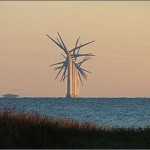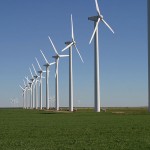As awesome as flying?

French tyre manufacturer Michelin recently held its 10th annual design challenge. The winner this time was a Serbian designer, Marko Lukovic. His idea of what a car might look like in 10 years is more like a rocket or fighter jet than a car. Lukovic’ car is run by Li-Ion batteries that will become smaller as today, the designer believes. It could be possible for the future drivers to charge them inside their home or office, much like a laptop or mobile phone. Cool idea? We will see, how right he is. The winning car project has excelled 1,000 contestants worldwide.
So probably we are moving like this by 2021. Let us know what you think about the movement of the future. How will car’s look like? Will there still be cars?
By the way, mashable has a quite impressive collection of more or less cool electric cars that you will find here.
Remember Chernobyl: History repeating after 25 years?
Today the world will remember the 25th anniversary of the Chernobyl nuclear power plant disaster. According to unconfirmed statistics more than a million people died because of the disaster. The meltdown and explosion back then sent radiation across Europe.
Today inhabitants of the Ukraine lit candles beneath a memorial containing pictures of the rescue workers and plant workers who died in the disaster. The Ukrainian president Yanukovych , who visited the scene together with russian president Medvedev said that “Chernobyl has become a challenge of planetary magnitude." Medvedev added: "Chernobyl will forever remain a symbol of huge human grief." He will propose a plan to boost safety at the world's nuclear power plants at the Group of Eight summit next month.
History repeating?
In the early hours of April 26, 1986, workers at the Chernobyl atomic power station in the then Soviet republic were carrying out a test on reactor four when operating errors and design flaws sparked successive explosions. Radioactive debris landed around the reactor, creating an apocalyptic scene in the surrounding area, while material also blew into the neighbouring Soviet republics of Belarus and Russia and further into western Europe.
What do you think, what did the world learn until today? Did we learn at least something? What are your personal conclusions on Chernobyl?
Here's a report of our DW-TV colleague Mareike Aden who met victims from the Chernobyl nuclear disaster, it's a brief history of the accident as well:
The Little Island That Could
Have you ever heard about the small Danish island called Samsø? It's home to only 4,000 people and stretches over about 103 square kilometers of land…and it's 100% energy self-sufficient! Using a combination of offshore wind power, solar energy and biofuels, Samsø has created a green haven, cutting CO2 emissions by an incredible 140% in just 10 years.
The model has been so successful that Samsø even exports energy to mainland Denmark and acts as a model for other islands that are interested in developing renewable energy. It's become a local attraction, too: around 20,000 people flock there during the summer. So what can the rest of the world learn from Samsø? Is a completely energy efficient life possible in bigger regions with large populations, too?
Happy Earth Day!
It's Earth Day 2011–a day for everyone, not just environmentalists, to think about the climate and take action! This year's theme is "A Billion Acts of Green." Earth Day organizers want the world to generate a billion acts of service to our environment before the Rio +20 UN climate conference in June 2012.
What are you doing to celebrate Earth Day? And will you take part in an "act of green?" Share your stories with us!
Google’s Big Investment
Google has made some major commitments to clean energy, but the company's latest announcement might just be the biggest. Google is investing $100 million into a wind park in the U.S. state of Oregon. This isn't any ordinary wind park, either–it'll be the biggest in the world. It's called Shepherds Flat and it stretches over 30 square miles (around 640 acres) of land. The park is expected to generate 845 megawatts of energy, enough to power more than 200,000 homes. The company says Shepherds Flat will be done by 2012–only a year away!
Google also announced it's teaming up with the U.S. Department of Energy to help electric car drivers find the nearest charging station. Basically, the internet giant will use its "Google Maps" program to create an online database with all the spots where drivers can "fill up."
So far, Google has invested a total of $350 million in green energy projects. Is Google doing a good job? Or are there other companies out there that are making an even bigger commitment to fighting climate change?











Feedback